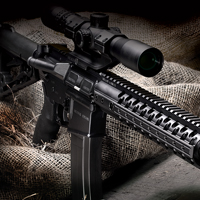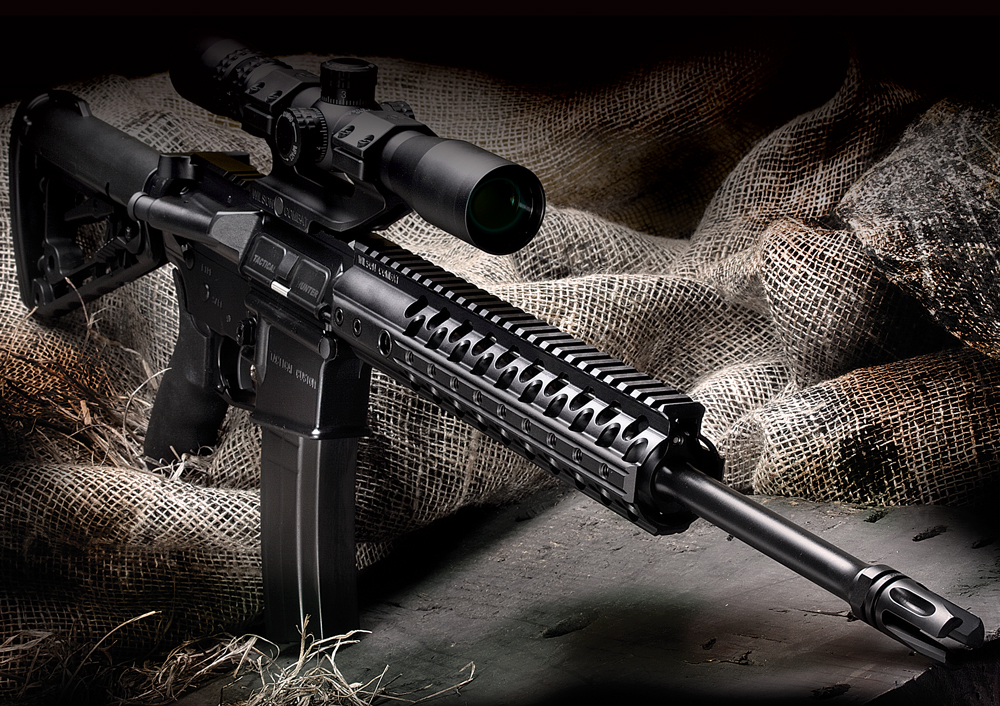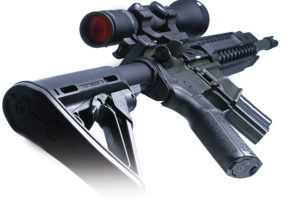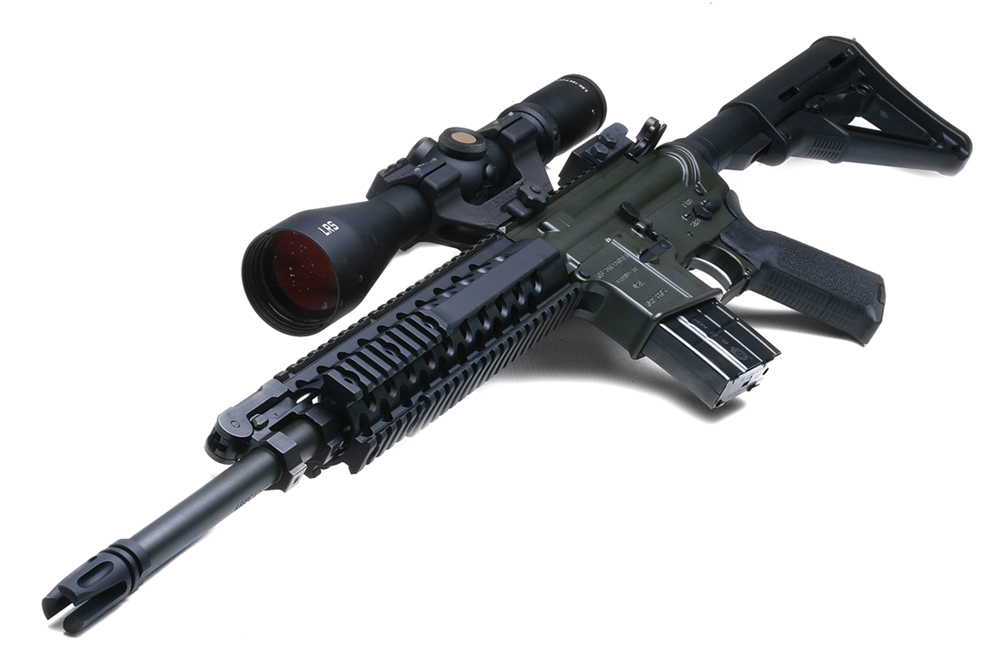

The Wilson Combat 6.8 SPC Recon challenges conventional thinking on rifles and calibers for law enforcement snipers or other tactical marksman.
I love to challenge rules and conventional notions — all cops should. Sometimes, I find that the rules in question are there for a reason, and under closer scrutiny are proven to exist for our benefit. Other times, I find that the rules have no grounding in practical purpose, and are actually there to our detriment.
All of us have been told at one time or another in our respective agencies when we dared to challenge or examine a particular rule such brilliant reasons for their existence like “because we’ve always done it that way” or even a more paternal/maternal “because”. Don’t you love a response like that, especially when the rule doesn’t make sense?
Well, I’m here to challenge some of the rules when it comes to the choice of a police precision marksman (hereafter referred to as “sniper”) rifle, and hopefully change the paradigm for at least some of you when it comes to them. So here goes:
Rule #1-A police sniper rifle needs to be a bolt gun. Who said that? Up until a few years ago, the bolt gun was the only choice. Today, with the advent of the modern accurized AR15 platform, that is no longer true.
Rule #2-The sniper rifle caliber must be the .308 Winchester. What advantages does the .308 bring? The round brings excellent accuracy, and a great deal of power. How much power? Probably more than we need in most civilian law enforcement situations.
Think about this; the average U.S. urban police sniper shooting distance is about 64 yards or less. How much of that power is wasted exiting the suspect’s head? Can we still take care of business with a milder recoiling caliber out of a standard AR platform gun? Yes, I think we can.
 Rule #3- The police sniper rifle needs to weigh 12 or more pounds for best accuracy and to fit the conventional standards. Look again at the standard engagement distance: 64 yards. This is a distance that we can select and control because we select our hide and shooting point. Why not start with a rifle like the 6.8 Recon that weighs 7.5 pounds sans scope, and just maybe maxes out around 10 pounds including a 21-round magazine?
Rule #3- The police sniper rifle needs to weigh 12 or more pounds for best accuracy and to fit the conventional standards. Look again at the standard engagement distance: 64 yards. This is a distance that we can select and control because we select our hide and shooting point. Why not start with a rifle like the 6.8 Recon that weighs 7.5 pounds sans scope, and just maybe maxes out around 10 pounds including a 21-round magazine?
Rule #4-A scope with 15- to 20-power magnification is required. In the real-world sniper mission do you use all that magnification power, or do you want to be able to see some things out of the periphery, such as other suspects?
Ok, consider the rules challenged. Now let’s look at the alternate possibility for what the standard police urban sniper rifle-the 6.8 SPC Wilson Combat Recon. Recon is an excellent name for the gun in my way of thinking. The word “recon” is defined by Webster’s Online Dictionary as a “military activity in which soldiers, airplanes, etc., are sent to find out information about an enemy”
My 6.8 Recon is set up with an 18-inch stainless steel, medium contour match-grade barrel with M4 chamber, what I consider to be the best quad rail on the market from Wilson Combat, an unloaded weight of only 7.7 pounds, a mid-length direct impingement low-profile gas block, full length upper rail, NP3 Coated LMT enhanced bolt and carrier, Wilson Combat’s Accu-Tac flash hider, and Wilson’s single-stage TTU (Tactical Trigger Unit) adjusted to a crisp 4-pound pull, Magpuls excellent CTR buttstock and MOE pistol grip with Tactical Trigger Guard.
The whole thing is finished out with Wilson Combat’s excellent Armor-Tuff polymer finish, which I selected in OD. This color allows the weapon to be used in my rural terrain without much worry of additional camouflage being added. The receiver and full length of the barrel are coated, but not the forend (which would be a nice additional touch).
There are short rail segments on the side of the forend setup that may be moved to different locations along the sides or bottoms of the rail based upon your needs. I like the fact that the forend isn’t covered with rail. How much of the stuff do we need, really? I bet most of the rail on your M4’s sit unused. One 15-round magazine (about perfect for a recon weapon-good capacity, yet not likely to dig into the dirt when fired from the prone position) from C-Products is included.
When I received the 6.8 Recon, I was taken with the hand-built precision that goes into any Wilson Combat firearm and decided to set it up as a precision gun by mounting a bipod from Shooter’s Ridge and a 2.5x 10 Nightforce Variable Scope with an illuminated reticle. After a bit, I thought I might be ignoring some of the great multi-mission capabilities of the Recon. I was not thinking outside the box with it. This became especially apparent as I did the questioning of what comprised a good police sniper rifle. The 6.8 Recon is perfect in this role, but it is capable of much more than just that.
Reconnaissance implies that those conducting it are going to be getting in close. It also implies that the folks conducting said reconnaissance may have to fight their way out of their observation position. For this purpose, the 6.8 Recon is also a fine choice. It is lightweight, with a barrel that is 2 inches shorter than the M16A1 or A2 main battle rifle. The overall length is even shorter if the Magpul stock is collapsed.
In order to make it more mission capable for in-close work, I dumped the Nightforce scope, and went with a Trijicon 4×32 ACOG battle sight with dual illuminated reticle, coupled with a Trijicon RMR with Amber Dot dot as a CQB backup. This fantastic combination seemed purpose built for the Wilson Combat Recon mission.

The ACOG is mounted on a Bobro quick-release mount and its 4-power magnification is plenty for the 64-yard law enforcement sniper/recon/observation mission. If things turn ugly, and the fight is on top of you, all you have to do is to raise your head and use the RMR sight for that really intimate moment.
Just to make sure all bases are covered, I mounted a set of Diamond Heads backup iron sights. Before I had actually gotten my hands on them, I considered the Diamondhead diamond shaped front and rear apertures to be a gimmick. I mean, how much could you improve on the concept of the basic iron sight these days beyond throwing some tritium on them? Well, like the old saying goes, there is always room for improvement, and the Diamondhead sights do just that!
These sights are the fastest to pick up on that I have ever tried. The diamond-shaped rear aperture just seems to lock onto the diamond-shaped front sight housing and bingo! There is the front post right where it is supposed to be. Don’t just think of them as backups, they would make a great primary setup if you want to keep your M4 as lightweight as possible. They flip up easily and lock right into place.
Note that with the ACOG setup, in order to take full advantage of the optical field of view, I had to mount the ACOG back to the point on the rail where you can’t flip up the rear Diamondhead. No biggie as you can’t co-witness them through the ACOG anyway. If things get bad and the mission changes or the ACOG setup goes down, just remove it, ditch it and then flip up the irons. That should take about all of two seconds or so. This is why any optic on a CQB rifle needs to be attached with a QD mount, and not screws.
I can tell you that the ACOG package with the Diamondhead sight is one of the best optics/CQB sighting combos available.
For Recon carry, I mounted a Tactical Link quick detachable/adjustable single point sling. I only had the black version on hand. If I was going to deploy this rifle in the field, I would use the OD green version. I moved the right side rail segment to the left side of the forend, directly aft of the rail segment that was holding the sling swivel and mounted a BLACKHAWK! Xiphos™ 90 Lumen strobing LED weapons light.
Here it can be operated in a hasty situation by the thumb of the left hand. Yes, you can actually operate an M4 type weapon and a combat light WITHOUT a vertical foregrip! I wanted to leave the foregrip off so as not to interfere with a “down in the dirt” operational position. With these additions, I now felt that I had completed the recon picture, and the Wilson Combat 6.8 was multi-mission capable and ready to rock.
Firing yielded no surprises, there really is no noticeable difference in recoil between a heavyweight 5.56 launching 75 grains and a 6.8 SPC launching 110. With the Hornady 110-grain BTHP version, the 6.8 has a 100-yard velocity of 2332 fps with a muzzle energy of 1328 ft./lbs. If you want to compare apples to apples, contrast the 110-grain 6.8 with the 110-grain .308 TAP URBAN round. Here you have a 100-yard velocity and muzzle energy of 2380 fps and 1956 fps respectively, with a penetration of only 9.25 inches (not enough in my book), and a maximum cavity of only 5.5 inches. Looks to me like the 6.8, thanks to the longer projectile and the better ballistic co-efficient, outperforms the 110 gr. .308 TAP URBAN round.
With the recon configuration, the Wilson SPC swings easily, and the 18-inch barrel length is really not a hindrance over a 16-inch barrel. I love the small diameter Wilson forend rail system. It is a huge improvement over the massive rails available on most M4 weapons systems.
The trigger is excellent, but not so light as to be dangerous for use in dynamic entry situations. The RMR sight on the Trijicon ACOG is easily accessed with just a slight raise of the head, and allows you to keep a good peripheral watch on the rest of the threat area, while maintaining a good sight picture. If you wanted to use this weapon as a strict entry weapon, I would recommend the substitution of the Crimson Trace MVF (Modular Vertical Foregrip) system for the BLACKHAWK! Xiphos light. The MVF gives you not only a bright LED light, but also the addition of a laser sight.
The Wilson Combat 6.8 SPC Recon-the multi-mission capable AR at its finest. Use it with the utmost confidence.
This article appeared in the December 5, 2011 issue of Gun Digest the Magazine.

Next Step: Get your FREE Printable Target Pack
Enhance your shooting precision with our 62 MOA Targets, perfect for rifles and handguns. Crafted in collaboration with Storm Tactical for accuracy and versatility.
Subscribe to the Gun Digest email newsletter and get your downloadable target pack sent straight to your inbox. Stay updated with the latest firearms info in the industry.


![Best Concealed Carry Guns In 2025 [Field Tested] Wilson Combat EDC X9S 1](https://gundigest.com/wp-content/uploads/Wilson-Combat-EDC-X9S-1-324x160.jpg)


![Best 9mm Carbine: Affordable PCCs [Tested] Ruger Carbine Shooting](https://gundigest.com/wp-content/uploads/Ruger-Carbine-Shooting-100x70.jpg)
![Best AR-15: Top Options Available Today [Field Tested] Harrington and Richardson PSA XM177E2 feature](https://gundigest.com/wp-content/uploads/Harrington-and-Richardson-PSA-XM177E2-feature-100x70.jpg)
